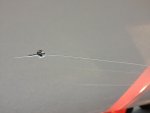Re: Hull issue..be worried??
Depending on the quality of the layup, if the chip has penetrated into the fiberglass mat (can't tell for sure from the picture), water could conceivably wick into the mat. Add freezing temps, and there is a potential problem. Not likely, but I wouldn't risk it. Plus, as noted, it doesn't look so nice.

There seems to be a very big misconception here on exactly what gel coat is, and what it does.
Gel coat is considered a cosmetic coating on a fiberglass layup, it is not waterproof, water will migrate through it, it is made from the same type of base resin (or slightly better) that is used in the laminate, it will not stop water from entering the laminate. Yes it may take slightly longer just because of the added thickness of the gel coat, but it still gets to the laminate. Water wicking up the glass fibers happens on every fiberglass part exposed to water, the laminate is not a sponge though, it is a very small amount. There are barrier coats that go behind the gel coat to help prevent water from causing problems in it, but gel coat is generally a poor barrier.
If gel coat was a better water barrier hulls wouldn?t blister. Blisters are caused by water migrating through the gel coat and in to the laminate where it can find interstitial sights where it may start to break down certain ingredients of the resin. The blister is formed after the water has absorbed minerals and salts then can?t pass through the laminate as easily as it once did, so it begins to apply pressure and expands the void. Some feel that laminates without gel coat have less of a chance of blistering because water can more easily migrate through and escape. (Chapters, or whole books could be written on the many reasons for blisters and not cover all of them, so I won?t go further on the subject.)
On trailer boats you could get away with no gel coat on the entire hull and the laminate would survive just about the same as with it, I?m not counting UV in this equation, just incidental immersion in water for several hours at a time. UV protection is where gel coat offers the best defense from harm to the laminate.
There are many thousands of boats out there with chipped or worn off gel coat that go decades with no issues, in fact I haven?t ever seen a chip like this one evolve into anything more than what it is, a cosmetic blemish on the surface.
From this standpoint there is no reason to repair it other than for cosmetic appeal, which is not what the question was about.
If it was mine I would fix it and move on, but it would not be because more problems would arise from it not being repaired.
I tend to over answer some of these questions, its not to be rude or argumentative, it?s because I am stickler for the details and facts on this type of thing, and all too often misconceptions take on a life of their own and become fact in tribal knowledge.
Joe Reeves (well known member on this site, 30+ year OMC mechanic) was asked one time about inaccurate information on the subject of motors frequently given in the J/E forum. He said he needed to learn to ignore much of it so it wouldn?t drive him crazy trying to correct all the inaccurate, but well intentioned advice. I may need to do the same thing.






















